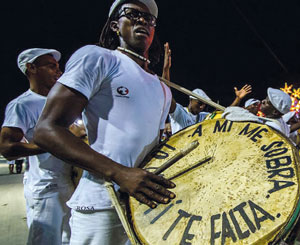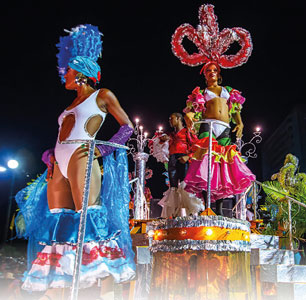 The carnival of the city of Santiago de Cuba retains unique qualities in the context of the popular festivals of our Caribbean country. It emphasizes the participation of all Santiago people in the celebration that, regardless of class and color, go out to the streets to express their joy for centuries.
The carnival of the city of Santiago de Cuba retains unique qualities in the context of the popular festivals of our Caribbean country. It emphasizes the participation of all Santiago people in the celebration that, regardless of class and color, go out to the streets to express their joy for centuries.
I do not think I have a single origin, because the Spanish influence can be seen in its festivals, in the decorated streets, in the dance companies competing for first place in the allusive topics during the revelry. Percussion instruments and rhythmic music that make the body vibrate and move; walks and pretexts demonstrate the African presence.
The tradition of Corpus Christi, which dates back to the early days of Spanish colonization, is considered by scholars as one of the essential roots of carnival. Nancy Perez, an authority on this subject, says its origin is independent of the oldest known religious traditions. I think numerous springs converge to feed it, originally religious.
The groups of "free colored" who were accredited by the ecclesiastical authorities organized to join the procession that accompanied the Blessed Sacrament, to honor it with their songs and dances. It was usually celebrated in late May or early June. Even in the late eighteenth century every day had its saint to celebrate, and life in Santiago de Cuba revolved mainly around the church and the ancient rural traditions. During Shrovetide, the people also amused with racing horses, release of liquids, and so on. These festivities were reduced and diminished their importance in the course of the Santiago urban building.
The guilds of free blacks which the councils of the nation conceal their own ceremonial beliefs, established various links with their parishes, so that their houses and temples were respected and employers could spend the night of the commemoration in the respective churches, to strengthen this relationship. They concluded, usually, with dances to the beat of drums or graves, according to the testimony of the district mayors.
Among the saints there was the figure of St. James, the patron of the city, celebrated each July 25, and neighbors attended for the procession of the image between the City Hall and the Cathedral, accompanied by the banner of Castile, symbol of power colonizer.
In the late eighteenth century, the provincial governor Juan Bautista Vaillant forbade the celebration of those drumbeats in the city considered prejudicial to public peace, while hot was the revolt of the coppersmith in the neighboring town of Santiago del Prado. Carnival is also banned during the impact on the Oriental Department of the violent immigration from Saint-Domingue, because of the uprising of slaves.
Nothing could prevent the continuation of a tradition established since the seventeenth century among the popular classes, and with the consolidation of the urban fabric Santiago acquired new nuances.
In the city of plantation
In the early nineteenth century, Santiago de Cuba organizes its urban network during the promotion of the slave plantation and slums of free artisans and agricultural workers grow. Carnival stands out as profane popular roots party, sponsored by government authorities, who favored the celebration of San Juan, San Pedro, Santa Ana and Santiago, and later Santa Cristina in honor of the Queen Regent.
This was a city with more than half of black or half blood population, where black fraternities were powerful and parades were organized during the Mamarracho Day. Also in the days of three Kings’ Day they roamed the streets to thank to their white godparents and receive their blessing. The role of the African grew in culture and provided new nuances to the carnival.
In popular neighborhoods, many troupes prepare to compete like the one located in the Tivoli neighborhood or Maria de la Luz Maria de la O, which are some of the oldest. To the Creole traditions tombs from Saint-Domingue would be incorporated, who accompanied the slave and free people from those neighboring lands. The brotherhood that was created or consolidated during preparations for showcasing the best of their troupes should not be overlooked as a substantial part of the carnival.
In the early nineteenth century carnival bans demonstrations responded to fear, always present, to free black people and slaves under the pretext that these were signs of backwardness and hindered the civilizing movement. For example, it was forbidden to wear black masks. However, despite its progressive distancing from religious festivals to become profane amusements, the mamarrachos continued to be celebrated with brilliance and enthusiasm, as long as the economic conditions of the region permitted.
As shown, the Carnival would be a strategic reason for celebration, because it provided a way of escape for the optimism of disadvantaged social groups. Among the privileged classes, carnivals passed from the street to the houses, theaters and recreation centers. However, walks or organized groups among young people were frequent for fun. There were attempts to apply sophisticated resources to parties, the sustained habit of entering the comparsa dancers in private homes, while the flourishing theater relations and solidarity ensured the streets to the humble. And in the sixties of the nineteenth century the carnival had become a worldly and popular festival for the enjoyment of all the inhabitants of Santiago de Cuba and the discharge of their everyday stresses.
Some insisted on its removal from the inadequate presence of the comparsa dancers and "little taste" of what they called "street masquerade". It was a useless attitude, since popularity in the city of fun that had permeated deeply. The English painter Walter Goodman, who lived in Santiago de Cuba for years, wonderfully describes this emergence of natural joy in his work Un artista en Cuba (An artist in Cuba).
At the outbreak of the uprising against Spain in 1868, although the Carnival faded the daubs paraded during the ten years of war. They were also held after the restart the struggle for independence in 1895. With the US occupation after signing the surrender of Spanish forces in 1898, the carnival demonstrations were affected. During the wars, the Spanish authorities supported the celebrations to deny the massive participation in those, but they did not take into account the vast possibilities for revolutionaries to infiltrate within the city in the revelry.
With the Republic
When the Republic was founded in 1902, the presumptuous oligarchy, determined to enter modernity and escape the African influence, tried to suppress carnivals again, while bypassing the role of the black people in the newly created nation.
The attempts were unsuccessful, as it was impossible to leave aside the African cultural presence in the Cuban identity. In the depths of the Machado dictatorship, carnivals were abolished in Santiago. Voices were raised to reject this absurd. "If we suppress the conga at all would mean that the poor classes do not have the right to have fun and entertain their leisure" (Pérez Rodríguez, 1988, Vol. II, p. 10).
The carnival that was a flattering vehicle of disseminator purposes was inserted in commercial propaganda in Santiago life. So, rides, prizes and kiosks were funded by beer company managers, or rum company managers or candidates eager to vote. Competitions for queens and ladies won a bigger role, influenced by beauty contests in the northern neighbor.
The postwar period brought about the growth of Santiago city center. Again, in the workers and poor people neighborhoods expectations were generated for the carnival; population growth accounted for a massive turnout at the most important festival of the city. Trocha Street reached greater popularity, still over Martí Street, considered the most important avenue of the city. The years 1940 and 1955 were especially prominent in the growth of the carnival, without losing anything; on the contrary, it earned uniqueness among all the festivities of Momo held in Cuba: the multi-ethnic and class participation made it evident. Verbenas areas were expanded, the streets were decorated profusely and congas were showier. The national and foreign tourism repeated again and again their visit to the city during these days.
As in the colony, and since the eighteenth century, the carnival fun protected the conspiratorial action against the excesses, this time from the pro-imperial tyranny. That is the reason why the assault to Guillermo Moncada Barracks was planned on Santa Ana Day in 1953.
Contemporaneity
 Tradition of Santiago carnival was perpetuated after the revolutionary triumph of January 1959. However, during the decade of the seventies and the following, the carnival suffered many vicissitudes, including the absence of the small private enterprise and centralizing distribution of food and beverage sales. Of course, also the effects of the US economic embargo on Cuba, which reduced opportunities for people to create their street dresses and ornaments.
Tradition of Santiago carnival was perpetuated after the revolutionary triumph of January 1959. However, during the decade of the seventies and the following, the carnival suffered many vicissitudes, including the absence of the small private enterprise and centralizing distribution of food and beverage sales. Of course, also the effects of the US economic embargo on Cuba, which reduced opportunities for people to create their street dresses and ornaments.
Today the celebration of Santiago carnival requires further studies to better conservation. On several occasions, the city government has convened seminars on the subject. Some people like Enrique Bonne, who led the Carnival Committee for many years in the revolutionary era, are consulted regularly. However, it is necessary to delve into the characteristics of neighborhoods, the growth of the city and those traditional formulas that may have permanently lost due to the increase for the emergence of new ones. Through research manifestations of the parties in the past can be identified. This is an important task to survive and endure this party that emerges from the bowels of the Santiago community.
The secular resistance of this party is in its most intimate and profound popular origin. Its conservation requires the same treatment in order not to be mystified and not to lose the uniqueness compared to other Cuban festivities. In the renovation is perpetuity. JoryFarr (. Duarte Jimenez and Recio Lovaina, 2005, p 192), a young American journalist, who left sense impressions on the essence of Santiago carnival and especially its enormous communicative potential, "There was no possible escape. A human mass huddled against me on all sides. A woman appeared before me from nowhere. She had black eyes, flat nose and thick lips that seemed carved. A thick black hair fell on her neck, while smiling at me over her shoulder she took my hands and put them on her hips. And in the following blocks she often leaned forward and then hard against me. When I answered in the same way, all the men around me clapped in approval. "
(Taken from The Brazilian Journal of Caribbean, Goiania, vol. X, no. 20).
Related Publications

How Harumi Yamaguchi invented the modern woman in Japan
March 16, 2022












